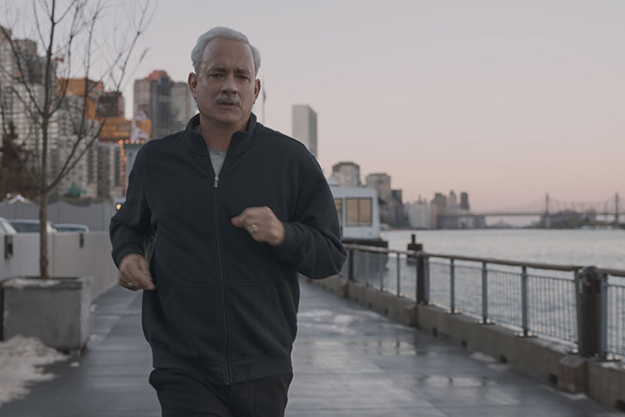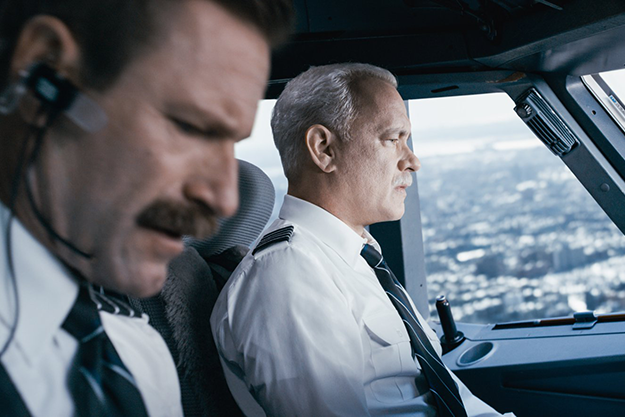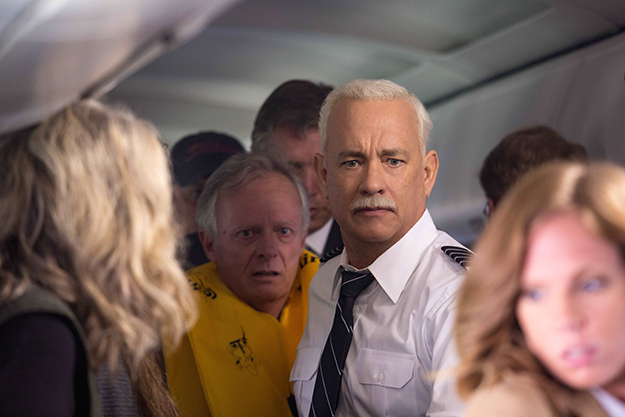Deep Focus: Sully

Sully’s restaging of US Airways Captain Chesley “Sully” Sullenberger’s landing of his disabled Airbus on the Hudson River, on January 15, 2009, shortly after takeoff from LaGuardia Airport, is so thrilling that it keeps the audience in a hammerlock even when the director, Clint Eastwood, unveils it in fragments or repeats it at varying lengths and from alternate points of views. There’s been no better use of IMAX since Brad Bird stuck Tom Cruise to the tallest building in the world in Mission Impossible: Ghost Protocol. Eastwood and Tom Stern, his cinematographer, cannily exploit the format’s height and detail. With their digital-effects team, they juxtapose Sully’s medium-range plane with Gotham’s ziggurats and towers in ways that make us see the New York City skyline in all its power and fragility, as if for the first time. Stern frames the twin-engine narrow-bodied aircraft slicing through New York’s urban canyons in terrifying fantasies and gliding just as scarily a few hundred feet above the water during its actual descent. Thanks to the precision of the editor, Blu Murray, the replays of the plane’s final flight never seem gratuitous: they’re always shocking or repetitive with a purpose.
In Tom Hanks, Eastwood and Stern have a human camera subject as urgently compelling as the Airbus: a star that can play a focused professional with a kind of heightened competence. The real Sully is actually more charismatic than Hanks (at least than Hanks is as a dramatic actor—in his comedy prime, he was magnetic). In the closing credits, when we see clips of Sully at a Flight 1549 reunion in the Carolinas Aviation Museum in Charlotte, where the plane is currently housed, his presence fills the hall. Still, when Hanks works with a tough-minded director, like Paul Greengrass in Captain Phillips, or an emotionally cool filmmaker like Eastwood, he is peerless at conveying, without pushing it, the feelings that roil beneath the surface of a well-ordered life (sometimes they shoot out volcanically), as well as the supreme satisfaction a craftsman takes in a job well done.
The film’s portrayal of Sully and copilot Jeff Skiles (Aaron Eckhart) carrying 150 passengers and a five-person crew to safety, leading by their example of competence and decency, emits a genuine inspirational allure. The film will go on to exaggerate the cruelty and myopia of a government bureaucracy (the National Transportation Safety Board). But it’s wonderful, early on, to witness the expertise and emotional commitment of a New York air-traffic controller, Patrick Harten (Patch Darragh, in a tremendously affecting performance), and his surreally steady give and take with his soft-voiced supervisor (Rob Treveiler). Sullenberger and Skiles appear to be a terrific team partly because Hanks, figuratively, seems to hand over the wheel in certain scenes to Eckhart, just as Sully depends on Skiles. And Eckhart responds robustly, with amusing alacrity. Later, the rescuers from nearby police and fire departments, the Coast Guard, and ferry services register as unsentimental, can-do individuals, including Vincent Peter Lombardi, who plays himself as the captain of the Thomas Jefferson, the very first of the first responders.

In the air and on the water, Sully soars, but on land, Eastwood and screenwriter Todd Komarnicki nearly ditch it. Although the movie credits Sully’s frank and personal memoir, Highest Duty: My Search For What Really Matters, written with the late Jeffrey Zaslow, as the source for Komarnicki’s script, Sully actually centers on a conflict that Sully and Zaslow largely ignored: the investigation of Flight 1549 by the NTSB. Reading Highest Duty (the new edition has been retitled Sully), we get a positive image of the NTSB and its investigation of airplane accidents, including Sully’s own. Four months after the water landing, Sully and Skiles go to NTSB headquarters to hear the contents of their cockpit voice recorder for the first time. Three NTSB officials, including two investigators and a recording specialist, join them in a small room, along with a representative from the US Airline Pilots Association. “Even in the safety of that office at the NTSB,” Sully writes, “it was disturbing for us to hear again the rundown of the engines, and to know we had been in the cockpit of that aircraft when that was occurring.” He’s astonished to realize that only “208 extraordinarily time-compressed seconds” passed between the instant he exclaimed “Birds!”—as Canadian geese flew into his two engines and disabled them—to his command, “We’re gonna brace.” Afterward, in a typically generous yet understated Sullenberger moment, the captain takes a moment to praise Skiles for being “right there” with him, through all of those “distractions.” Then they go back to listen to the tape again and again.
In the movie, that scene is treated as the climax of an extraordinarily antagonistic NTSB inquiry, with investigators zeroing in on Sullenberger and Skiles mere hours after the landing. At first, we’re incensed that NTSB members harshly prosecute the pilot and first officer. They challenge every claim the flight crew makes, whether about the simultaneous failure of two engines or their inability to land safely at either LaGuardia or Teterboro Airport in New Jersey. Eastwood and Komarnicki frame the conflict as the clash between practical wisdom (Sully) and computer models (the NTSB’s technocratic bureaucrats). Because Hanks in this film, unlike Bridge of Spies, wears the hero’s wealth of experience lightly, and Eckhart turns Skiles into a robustly appealing sidekick, it’s too easy to be outraged on their behalf.
Sullenberger did experience PTSD, so the filmmakers can argue poetic license in overstating the NTSB probe to accentuate the pressures on their hero. But even on these terms, the trumped-up melodrama grows wearing. It seems ludicrous that the NTSB would pack all their research and questioning into a week or two after the incident, not giving Sully time to fly West to visit his wife Lorrie (Laura Linney) and their two girls (who are virtually unseen). In fact, the actual investigation lasted 18 months. It appears to be strategically dumb that NTSB agents would signal to Sully that he’ll likely be condemned for endangering lives, instead of saving them, before the evidence is in. Sully has said, “The story being told came from my experiences, and reflects the many challenges that I faced and successfully overcame both during and after the flight.” In the press kit Hanks notes that Sully told him, “Look, these are good people on the other side of that table.” But that’s not how Eastwood directs them. They’re slippery (Jamey Sheridan), bullying (Mike O’Malley) or mysteriously abashed (Anna Gunn), until, with excruciating melodramatic predictability, they see the errors of all their ways.

Everything on land ends up hokey or phony, including a bar scene that’s full of booze-soaked clichés, and a sequence that’s meant to place a handful of passengers in our minds—a middle-aged woman with a wheelchair-bound mother, and a father, son, and family friend who get the flight’s last three seats past the nick of time (the gate agent cuts them a break), then are separated at the rescue. Linney is given next to nothing to do as Lorrie Sullenberger save to express confusion, exasperation, gratitude, and support in a series of clipped serial phone calls. It’s a thankless role, but it could have been a rich one: Sully’s book revolves around his hope to achieve a better balance between work and family.
Komarnicki has written flashbacks to Sully’s life as a Texas boy with a flight instructor, and to his years of service as an Air Force fighter pilot who was never sent into battle. These backward looks are few and far between, and they’re too skimpy to add up to a vibrant portrait. (The script skips over major traumas in Sullenberger’s life, like the suicide of his father in 1995.)
But two-thirds of Sully is a crowd-pleaser that doesn’t insult our intelligence on the few occasions when it is required. The badinage between pilot and copilot sounds lively and feels authentic, and it’s often right out of the book, like the moment when Skiles tells Sully he Googled him and found the website for his safety consulting business. “I read all about your company,” Skiles says. “Man, I thought I was a good bullshitter, but you take the cake!” The trio of stewardesses on Flight 1549 (played by Molly Hagan, Jane Gabbert, and Ann Cusack) display their fair share of heroism, reading the situation perfectly and yelling out to the passengers, in near unison, “Brace, brace! Heads down! Stay down!” William Dean Howells wrote in the 19th century that the American public wants “a tragedy with a happy ending.” Sully may be just what the mass audience wants in the 21st century: a disaster film with a happy ending.
Michael Sragow is a contributing editor to Film Comment and writes its Deep Focus column. He is a member of the National Society of Film Critics and the Los Angeles Film Critics Association. He also curates “The Moviegoer” at the Library of America website.







